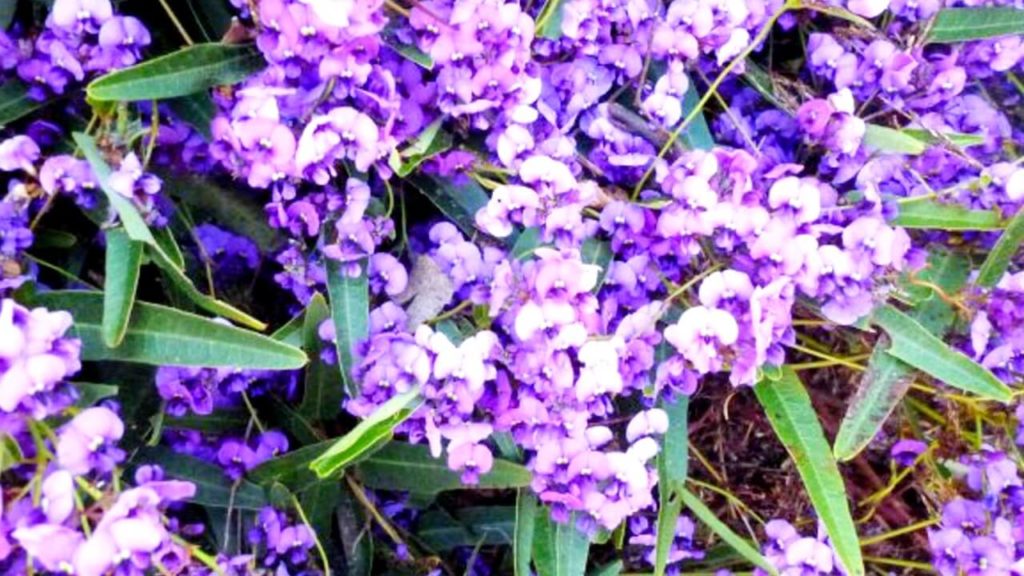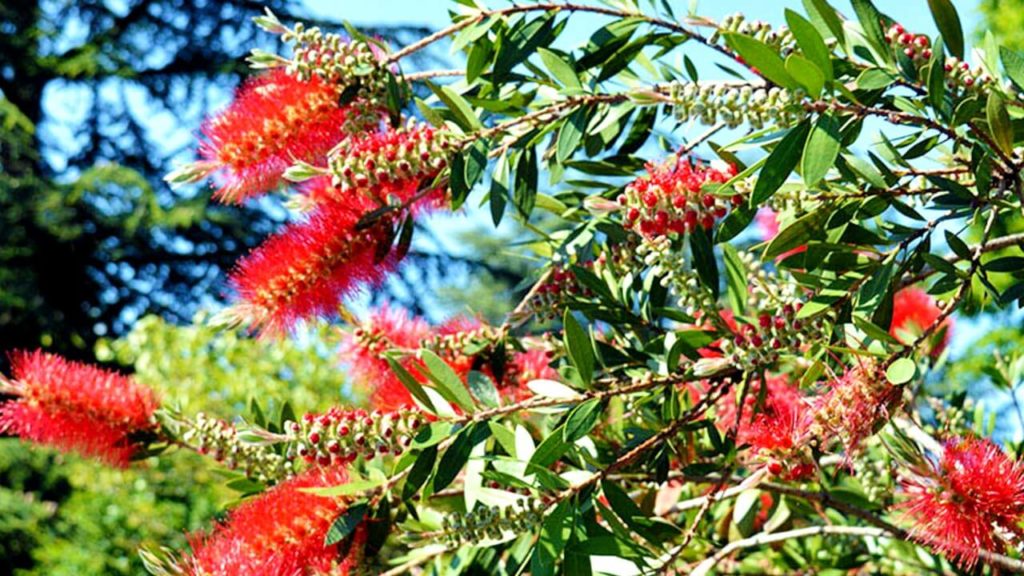Australia boasts around 24,000 diverse species of native plants, many of which can be sustainable, low-maintenance, and wonderful additions to your garden.
Growing native Australian plants doesn’t just make your outdoor space look great — it helps to create a safe and nourishing environment for Aussie wildlife to flourish too. Plus, it’s surprisingly easy to cultivate these special indigenous flowering plants, shrubs, climbers, and orchids at home.
Find out how to bring a little of our country’s natural beauty into your own backyard with our Australian native plants guide.
Climbers
What is the Happy Wanderer (Hardenbergia)?

The Happy Wanderer is a low-maintenance, fast-growing climber that produces a mass of gorgeous, deep purple flowers in mid-winter. This colourful native Aussie vine is a magnet for bees due to the abundance of nectar, the raw material used by bees to produce honey, hence making it an eco-friendly addition to your garden as well.
The hardy Happy Wanderer grows best in frost-free spots where it can soak up lots of direct sunshine, but it can still do well in semi-shaded areas. As such, this climber can be planted in most regions of Australia.
Plant in free-draining soil or native potting soil and regularly prune after flowering to keep in shape. Use a native controlled-release fertiliser after bloom and water as needed, paying slightly more attention to hydration during summer.
What is the Bower of Beauty (Pandorea Jasminoides)?

The Bower of Beauty is an ideal climber for fences, pergolas, and trellises. From late spring to summer, it blooms gorgeous clusters of white or pale pink flowers with vibrant fuchsia centres.
This fast-growing climber thrives in warm, temperate climates across Australia and will always grow to reach the sunlight, preferring full sun or part shade. Propagate from fresh seedlings in spring, or grow from cuttings in summer.
This low-maintenance plant requires no fertiliser or watering, except in hot regions with little rainfall.
Keep in mind that the Pandorea species commonly develop very strong roots, and so should not be planted close to underground pipes.
Flowering Plants

The velvety, flame-orange flowers of the Kangaroo Paw alone make it worthy of a spot in your Australian native garden.
This iconic WA plant does best in sunny, well-drained spots and slightly acidic soil, and can flourish in a plant pot too.
It takes about four weeks to grow a Kangaroo Paw from seed, and it can be planted anytime from March to October, or even in early November.
Most species of Kangaroo Paw die back and are dormant in winter, and produce their beautiful flowers in the spring and summer months.
What is the Spider Orchid (Caladenia)?

The native Aussie Spider Orchid is a much more unusual and interesting alternative to its popular relatives, such as the Phalaenopsis, Cattleya, and Vanda orchid.
This small to medium-sized plant blooms sprawling, pale pink flowers from August to October and gets its name from the spiky, spider-like spotted sepals that can hang 25 centimetres or more.
The Spider Orchid can grow from 10-60 centimetres in height in well-watered, warm, and humid habitats that get plenty of bright, indirect sunlight.
After flowering, move the orchid to lower light levels for a little rest.
What is the Eucalyptus (Gum Trees)?

Eucalyptus is another iconic Aussie plant that does very well in residential gardens. And while it grows about 2-3 metres each year and can reach heights of between 10-55 metres, it also makes a great house plant. Eucalyptus offers many benefits outside the garden too — as a herbal tea, ointment, insect repellent, and more.
This indigenous Australian plant is easily distinguished by its menthol-like scent, colourful flowers (pink, red, yellow, white, or cream) and waxy fruit (gumnuts). Position in full sunlight using well-drained soil and water it regularly, especially during the warmer months.
Note that while Eucalyptus does very well in a pot, it won’t take well to ground transplantation after it has outgrown its home.
Shrubs
What is the Spotted Emu Bush (Eremophila maculata)?

This low-growing, spreading shrub belongs to the Figwort family of plants and usually grows quickly to under 2.5 metres tall, making it an excellent choice for low hedges.
It gets its name from its distinctive spotted flowers, which bloom in various vibrant colours during late spring, including bright pink, white, red, orange, and yellow.
The Spotted Emu Bush loves hot, sunny arid environments — it is widespread in WA and South Australia in particular.
This low-maintenance shrub requires very little water and can withstand a good amount of wind too, making it the perfect choice for sunny coastal gardens.
What is the Moonlight Grevillea?

The ever-blooming Moonlight Grevillea is a fast-growing, evergreen shrub with cream, nectar-rich flowers that are extremely attractive to birds and insects.
This hardy native bush can also adapt to a wide range of climates, making it suitable for most Australian homes.
Reaching heights of up to 360 centimetres tall and widths of up to 240 centimetres, the Moonlight Grevillea is ideal for creating hedges or windbreaks.
Grevilleas are easy to grow from either seeds or cuttings and are best propagated between December and March. Plant them in a sunny location and water well until fully rooted.
What is the Bottlebrush (Callistemon)?

The Bottlebrush is called such because of its spectacular bushy, cylindrical flower spike that blooms either red (Crimson Bottlebrush and River Bottlebrush) or yellow (Lemon Bottlebrush) in spring.
This medium-sized woody shrub makes an excellent garden plant, growing up to 4 metres tall and proving irresistible to nectar-feeding insects and birds.
The hardy Bottlebrush is largely frost- and damp-tolerant and grows well in most temperate parts of Australia. It can be easily grown from seed in a variety of soils too.
Sow during spring and summer and position in areas that bask in full sunlight to produce the best flowers, then prune regularly to keep in shape.
Contact West Australia’s Garden Experts
For more advice on Australian native garden plants, get in touch with us at Mulches and More. We supply a range of high-grade, competitively priced landscaping and gardening supplies for both commercial and residential projects.
If you would like more advice on what native Australian plants would suit your garden, send us an enquiry, email daniel@mulchesandmore.com.au or call 0407 084 734!
